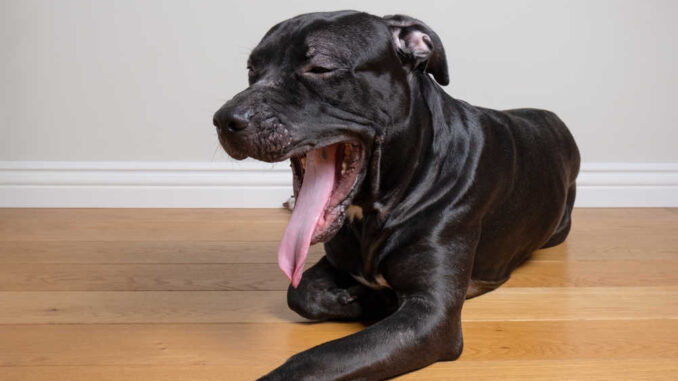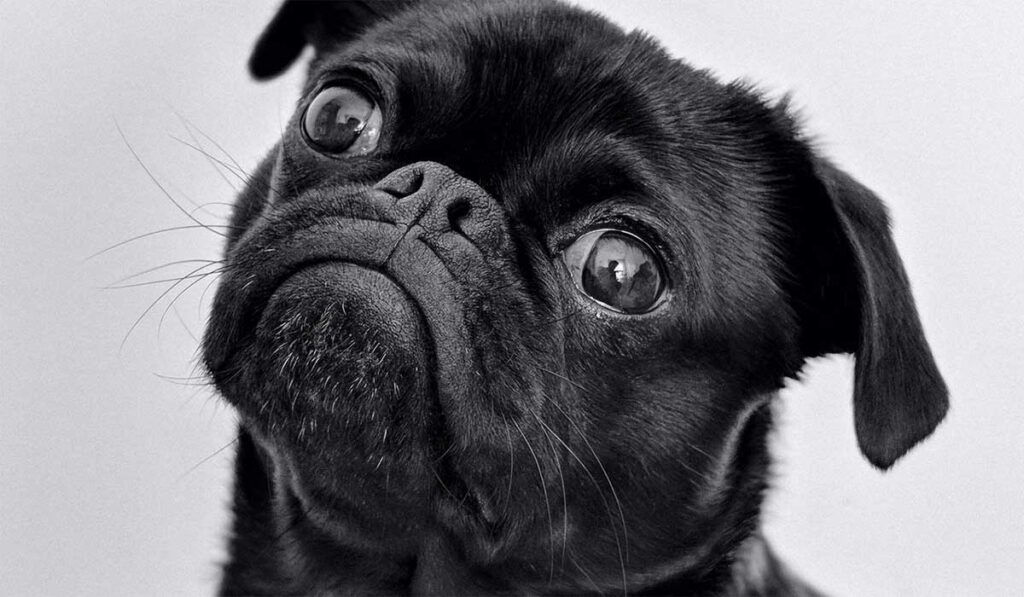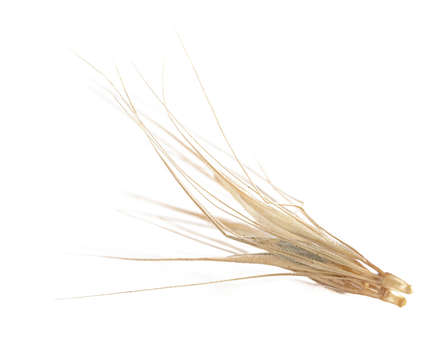
This article was updated on March 9th, 2024
As a veterinarian, my heart always sinks a little when I see that the next patient is coming in for an issue with their breathing. Unusual or weird breathing patterns in dogs may include wheezing, coughing, rapid or labored breathing, or shortness of breath. In this article, we will review the most common causes along with videos to see what they look like.
Though not always something serious, these sorts of medical problems have the potential to be severe and even life threatening. Thankfully, for most patients, issues with breathing will be mild and short-lived. As a vet, my role is to ensure the dog is coping well, figure out why they’re breathing in a strange manner and to get things back to normal asap!
Common problems causing weird breathing in dogs [with videos]
1. Canine Tracheal Collapse
Collapsing trachea is a relatively common, particularly in small breeds like Yorkies, Chihuahua and Pugs (1)1 Owners often bring their dogs to my practice after noticing slight changes in their breathing and a cough that has persisted for several weeks or months.
Here is a great video showing what Tracheal Collapse sounds like in dog:
This condition is generally diagnosed by a chest x-ray, though other tests are employed to rule out any other underlying issues. Medicine like bronchodilators and anti-tussives form the main part of therapy.
There are lots of things we can do from home to manage this condition including ensuring the dog is not overweight, not over exercised and does not get over heated. They do better with body harnesses rather than neck collars.
2. Brachycephalic Obstructive Airway Syndrome (BOAS)
With the rise in popularity of snub-nosed breeds like Pugs, Shih Tzus and Bulldogs, I’m seeing cases of BOAS multiple times a week nowadays. While some dogs have mild ongoing symptoms, others will have more severe signs which worsen with time.

These dogs tend to snort and snore, especially when lying down and when exercising. We sometimes see clear nasal discharge and dogs can be quite exercise intolerant, particularly in the heat.
Here is a video showing what it may sound like:
Keeping these dogs slim is key, as is managing their environment so they’re cool and calm. For those with more severe disease, surgical treatment is important and this can include interventions such as widening the nasal cavities and shortening the palate.
Vets will diagnose this condition by observing the patient and checking for any underlying issues such as heart disease and bronchitis. Diagnosing BOAS is usually done with an upper airway exam under light sedation and imaging. A grading system from 0-3 has been developed to assess the severity in the individual (2)2 The prognosis will depend on the severity and more advanced disease can really impact on the quality of life.
3. Heart disease
There are a wide range of cardiac conditions that dogs can suffer from. One of the most common is mitral valve disease, and this is especially prevalent in the King Charles Cavalier in who it can be 20 times more likely than in other breeds(3).
This website has a video with a nice illustration of a Pomeranian with a cough caused by heart disease: https://heartsmart.vet.tufts.edu/coughing/

As fluid builds up, dogs can develop a soft cough which worsens after they’ve been lying down (and the fluid has pooled). We may also notice signs such as panting, trouble coping in the heat and a bloated tummy.
Dogs can benefit from a range of prescription medicine and starting the medicine early in the disease can improve quality and duration of life. It can also help to feed a heart health diet with low levels of sodium. Learn more about heart disease in senior dogs.
4. Foreign body in airways
In the summertime, I sometimes encounter patients who have sniffed up or partially swallowed a foreign object like a fox tail or grass blade. These dogs develop a coughing and retching which develops abruptly and can cause them distress. They can also exhibit wheezing, gagging, or choking sounds, often accompanied by distress or difficulty breathing.

It is best to have these dogs seen by their vet as soon as possible for treatment. The vet will examine their airway under sedation and quickly remove any foreign material. We don’t want the object to move further down in the lungs, so time is of the essence.
5. Reverse sneezing
Reverse sneezing can cause abrupt and unusual breathing that will panic even the most seasoned owner if they’re unsure what is going on. Reverse sneezing in dogs is characterized by rapid and noisy inhalations, often sounding like a snorting or honking noise. It can be mistaken for coughing or choking but is typically harmless and resolves on its own.
Here is a video showing what reverse sneezing sounds like:
I’ve found smaller dogs including Terriers and Shih Tzus are more prone to this unusual sneezing and a bout can last about 30 seconds. While some owners tell me that they do things like massaging their dog’s neck or blowing on their face during an episode, the dog will stop by themselves and is in no danger.
If your dog is suddenly reverse sneezing much more than usual or it is interfering with their day-to-day life, your vet may suggest some tests like a rhinoscopy (camera in the nose) and chest x-ray, to rule out anything else.
If there are any underlying causes such as seasonal allergies, addressing these can make the sneezing less common. Read our article about Dogs Sneezing Due to Allergies.
How do you know if a dog’s weird breathing is an emergency?
I always say to my clients if you’re concerned by your dog’s breathing, have them checked out. You know them best and a change in breathing has the potential to be something serious.
Some red flags would include:
- a reduced ability to exercise,
- panting when there’s no explanation why (like hot weather or recent exercise),
- pale or grey gums,
- any breathing difficulty.
First-aid at home to help your dog’s breathing
From home, we are limited when it comes to assisting dogs with breathing trouble. While you wait for your vet appointment, it can help to:
- Keep them calm and relaxed
- Ensure the air is well ventilated and free of things like dust and smoke
- Use a donut bed when they sleep, to elevate their neck
- Maintain a cool room and avoid over heating when e.g. in the car
- Keep them slim and trim.
Any sort of change in breathing, wheezing, new cough or labored breathing requires a vet visit.
An urgent vet visit is required when we think our dog is struggling in any way. This can include if their resting breathing rate is 30 breaths a minute or more, if they cannot settle or have an ongoing cough, if they’re standing with their arms wide apart of if they have grey or blue gums. Any concern you have that your dog is not coping would warrant an immediate call to the emergency clinic.
Tip: record a video & send it to your vet
If you have any videos demonstrating a recent concerning episode, these will be very useful for your vet to assess. It’s also a good idea to video them while sleeping or resting, so the vet can assess their ‘natural’ breathing rate.
Your veterinarian visit
Your vet will want to know about any previous breathing issues your dog has had and if they’re on any medicine. They’ll also enquire about their heart and lung worm prevention.
They’ll quiz you on recent changes such as a new exercise regime, trouble sleeping, difficulty keeping up on walks or a recent cough.
Diagnosis & cost of diagnosis
Initially, your vet will check your dog over, listening to their heart and lungs, assessing their capillary refill time and checking their pulses.
If concerned, they may then discuss some further diagnostic tests such as an upper airway exam, heartworm test, chest x-ray and/or bronchoscopy.
The cost of making a diagnosis can be anything from a few hundred to a few thousand dollars, depending on the type of imaging and other tests required.
Vet treatments & costs
What treatment is needed depends on why your dog has unusual breathing. Something like reverse sneezing won’t need specific therapy while heart disease usually needs ongoing, daily medicine that can cost several hundred dollars a month, with the cost being higher for larger dogs.
For those in respiratory distress, they may need interventions including oxygen, fluid therapy and sedative medicine.
References
- http://vetfolio-vetstreet.s3.amazonaws.com/mmah/59/a9fead44394c67ae1dc45956256fe5/filePV_28_05_373.pdf
- https://www.vet.cam.ac.uk/boas/about-boas/recognition-diagnosis
- https://www.researchgate.net/publication/282879630_Mitral_Valve_Disease_and_the_Cavalier_King_Charles_Spaniel
- Tracheal Collapse, Justin D Payne et al. [↩]
- Cambridge Department of Veterinary Medicine ‘About BOAS’. [↩]
Disclaimer: This website's content is not a substitute for veterinary care. Always consult with your veterinarian for healthcare decisions. Read More.


Be the first to comment